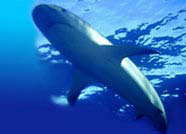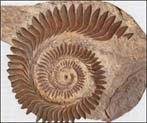


The Shark Age

 |
 |
 |
|||
| Home | Evolution
| Classification
| Glossary | Biology
| Behavior | Shark
Repellent | Shark
Conservation | Do's &
Don'ts | Did You Know?
The Shark Age |
 |
||||
|
|
||||||||||
|
The Shark Age: (Start Of Carboniferous Period-360
million years ago)
This ageis also remarked as the "Golden Age of Sharks". By the Start of Carboniferous age Sharks diversified  and proliferated to a great extent. In addition to obvious Shark like
species, there was some which can be only described as bizarre. Stethacanthus
probably grew up to 3.4 m (11 ft) long and differed from any other shark,
living or dead, in having a helmet of small teeth on its head and a curious
structure shaped like a triangular shaving brush sticking out of its back,
roughly where its anterior dorsal fin should be. This was topped by dozens
of teeth, small ones at the front and larger teeth at the back, and was
present in both male and female sharks. Such a conspicuous and awkward
structure must have had an important function, but what this could have
been can only be speculation. It may have played a role in courtship,
had something to do with defence, or maybe it enabled Stethacanthus to
anchor itself, like a modern remora, to the underside of a larger fish.
and proliferated to a great extent. In addition to obvious Shark like
species, there was some which can be only described as bizarre. Stethacanthus
probably grew up to 3.4 m (11 ft) long and differed from any other shark,
living or dead, in having a helmet of small teeth on its head and a curious
structure shaped like a triangular shaving brush sticking out of its back,
roughly where its anterior dorsal fin should be. This was topped by dozens
of teeth, small ones at the front and larger teeth at the back, and was
present in both male and female sharks. Such a conspicuous and awkward
structure must have had an important function, but what this could have
been can only be speculation. It may have played a role in courtship,
had something to do with defence, or maybe it enabled Stethacanthus to
anchor itself, like a modern remora, to the underside of a larger fish.
While the earliest fossil sharks superficially resembled modern sharks, later species from the 'golden age of sharks' appeared in all manner of curious shapes and sizes. Top, Cladoselache; middle, Helicoprion; bottom, Stethocanthus. Helicoprion  this primitive form of shark is poorly known, but has a bizarre pattern of teeth, which is instantly recognizable. The Helicorprions formed a whorl erupting from the back of a semi-circular 'conveyor belt arrangement', but the teeth did not fall away at the front as in modern sharks. Instead, they were rotated under the apex of the lower jaw and then back up into a cavity under the jaw where they were stored in a tight spiral. Why these sharks possessed such a bizarre dental arrangement is another mystery. The tooth whorl from the fossil shark Helicoprion was at the tip of the lower jaw. The older teeth are at the center of the whorl, which is about 20 cm (7.8 in) in diameter. Apart from these, there were giants also whose fossils have been found. Enormous fossil teeth from a shark with a mouth a metre (3 ft) wide and a body 6 m (20 ft) long have been found in Lower Carboniferous deposits in North America. With the giant placoderms gone at the end of the Devonian, these enormous sharks would have been the largest vertebrate predators in the sea. |
|
|||||||||
| Sitemap | Reach To Us | Jimtrade - Business Directory of India | ||||||||||